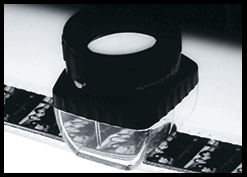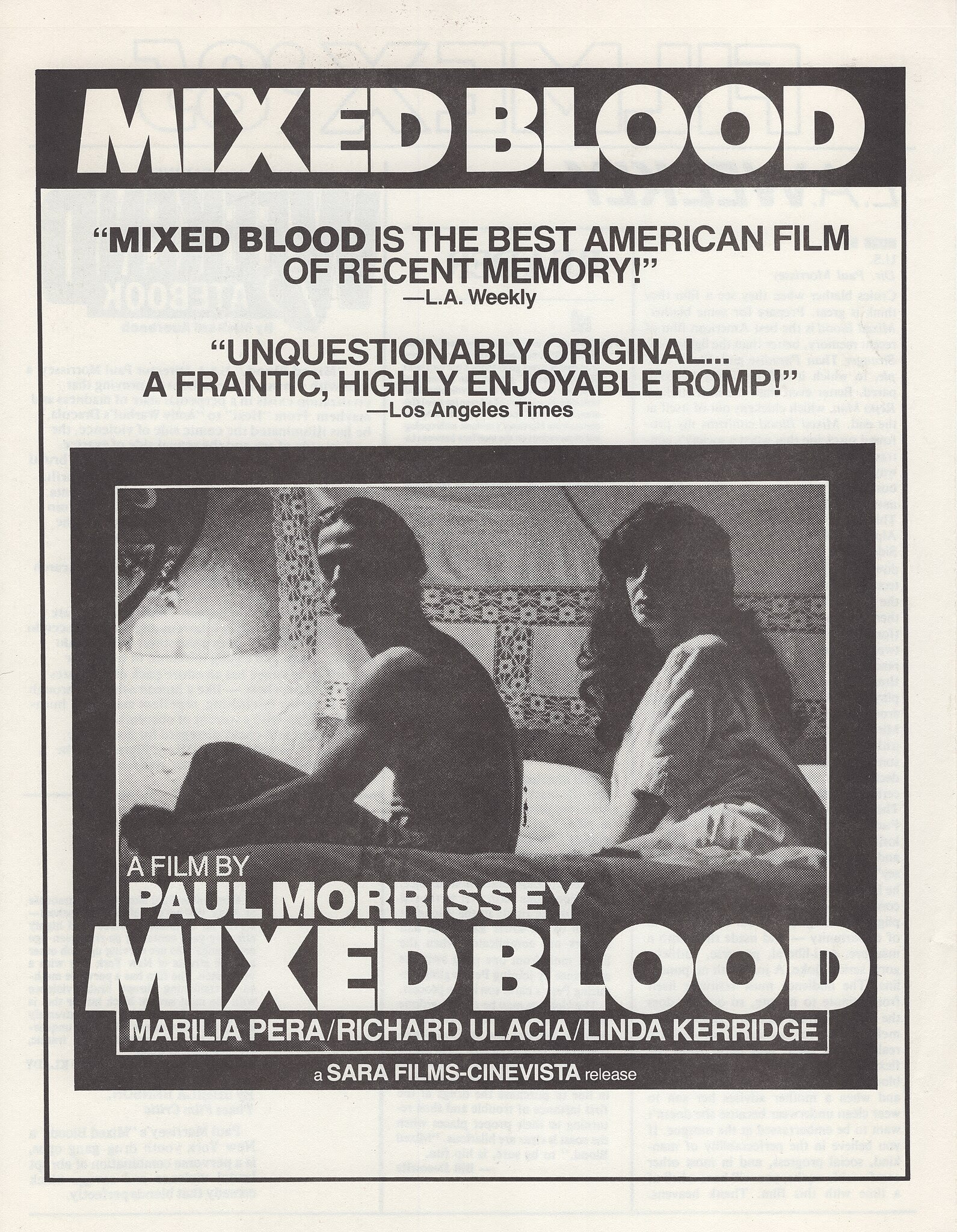Bookending New Hollywood: Joseph Cates' WHO KILLED TEDDY BEAR? and Paul Morrissey's MIXED BLOOD
/Gartenberg Media Enterprises is pleased to distribute new 4K restorations by Cinématographe of two seminal New York City thrillers — Joseph Cates’ WHO KILLED TEDDY BEAR? and Paul Morrissey’s MIXED BLOOD — to North American cultural institutions as Digital Site Licenses.
Released in 1965 and 1984 respectively, WHO KILLED TEDDY BEAR? and MIXED BLOOD both bookend and typify the "New Hollywood" era of the late 1960s and 1970s. Their transgressive explorations of violence, sexuality, social taboos and urban dysfunction emulate such better-known films as MIDNIGHT COWBOY (1969), THE PANIC IN NEEDLE PARK (1971), and TAXI DRIVER (1975).
SAL MINEO IN WHO KILLED TEDDY BEAR?.
Directed by noted television and Broadway producer Joseph Cates and co-written by comic book creator Arnold Drake, WHO KILLED TEDDY BEAR? is a lurid time capsule of mid-1960s Times Square, evocatively shot on location, in stark black and white, by Joseph C. Brun (Hatari, 1962; Flipper, 1963). In Cates’ film, a Manhattan disco hostess named Norah Drain (Juliet Prowse) finds herself the victim of a stalker and obscene phone caller. NYPD Lieutenant Dave Madden (Jan Murray) overhears her complaints at the precinct and takes a personal interest in Drain’s case, finding himself drawn not only to Drain but also to the seedy landscape of Times Square. As Drain begins to question the intentions of Madden, a sullen busboy at her workplace (Academy Award-nominee Sal Mineo) reveals himself as her stalker, putting her in a fight for her life in her apartment, workplace, and on the streets of New York City.
MIXED BLOOD.
Written and directed by Warhol collaborator Paul Morrissey, MIXED BLOOD is a similarly grimy descent into urban violence and malaise that is often punctuated by moments of gallows humor. In it, Rita la Punta (Marília Pêra), a Brazilian single mother living in New York’s Alphabet City, resides with her drug-dealing son Thiago (Richard Ulacia) and his gang of teenage delinquents. In an attempt to control the drug trade below 14th Street, Rita goes against the leader of a rival neighborhood gang, Juan the Bullet (Angel David), spurring a turf war. When Carol (Linda Kerridge), a friend of a drug lord known as The German (Ulrich Berr), expresses an interest in Thiago, the situation becomes even more complicated. Featuring a colorful ensemble cast that includes Warhol superstar Geraldine Smith (Flesh, 1968) and the screen debut of John Leguizamo, MIXED BLOOD is an essential (if often overlooked) entry into the canon of independent films made on the streets of New York in the 1980s.
WHO KILLED TEDDY BEAR? is a fascinating precursor to the dissolution of the Hays Code and the rise of New Hollywood in the late 1960s. Released in 1965, Cates' film was groundbreaking for its depiction of such taboo subject matters as incest, homosexuality, voyeurism, and pornography, years before such topics would be deemed “acceptable” content for movies.
ORIGINAL THEATRICAL RELEASE POSTER FOR WHO KILLED TEDDY BEAR?.
The mid-1960s through the early 1970s were a pivotal chapter in American society, one characterized by widespread socio-cultural revolution — and dysfunction — which was reified in contemporary cinematic trends. As noted by film critic Robin Wood in his book HOLLYWOOD: FROM VIETNAM TO REAGAN… AND BEYOND:
Although Classical Hollywood had already been dealt a series of death-blows, it might have taken a much longer time dying had it not been for the major eruptions in American culture from the mid-60s and into the ‘70s: overwhelmingly, of course, Vietnam, but subsequently Watergate, and part counterpoint, part consequence, the growing force and cogency of radical protest and liberation movements—black militancy, feminism, gay liberation… The obvious monstrousness of the [Vietnam] war definitively undermined the credibility of “the system”… the questioning of authority spread logically to a questioning of the entire social structure that validated it… yet this generalized crisis in ideological confidence never issued in revolution. No coherent social [or] economic program emerged… Society appeared to be in a state of advanced disintegration, yet there was no serious possibility of the emergence of a coherent and comprehensive alternative. This quandary can be felt to underlie most of the important American films of the late ‘60s and ‘70s… accounting for their richness, their confusion, and their ultimate nihilism… The[se] films seem to crack open before our eyes.
ELAINE STRITCH (CENTER) AND JAN MURRAY (FAR RIGHT) IN WHO KILLED TEDDY BEAR?.
While WHO KILLED TEDDY BEAR? features a cast from the Hollywood studio era (Mineo, Prowse, Broadway vet and occasional film actress Elaine Stritch), its content is far bleaker and more controversial than what would have typically appeared in a feature film produced under the studio system. Cates’ film thereby reflected the fatalism and discordance of the times and forecasted the gritty realism of the forthcoming New Hollywood era. It may come as no surprise, then, that when WHO KILLED TEDDY BEAR? was first theatrically released in the United States, nearly five minutes of Cates’ footage was censored. As noted by Cates’ grandson, the filmmaker Owen Kline:
Of all the lurid discoveries hiding in the lost director's cut [of WHO KILLED TEDDY BEAR?], the most staggering was a moment of Mineo sifting through nudist magazines in a Times Square adult book store. The last title he picks up is a gay pulp novel called BEACH STUD. Mineo was already running from gay rumors in the tabloids when he fearlessly took on the character in TEDDY BEAR (it officially put him on the “weirdo list,” as he put it), but to us, restoring this lost detail cements the film's already-beloved status as a touchstone of Queer Cinema.
JULIET PROWSE IN WHO KILLED TEDDY BEAR?.
Writing for the New York Times, critic J. Hoberman recently characterized WHO KILLED TEDDY BEAR? as an “ur TAXI DRIVER,” noting its stylistic and thematic similarities to Martin Scorsese’s violent and critically-acclaimed 1975 thriller, which has since become one of the most identifiable works of the New Hollywood era. When Film Forum premiered Cinématographe’s new 4K restoration of WHO KILLED TEDDY BEAR? in New York City in August 2025, their program note highlighted both the prescience and historical significance of the film’s content:
TEDDY BEAR seethes with a sweatily frustrated libidinousness: as the camera caressingly photographs the faceless voyeur in his jockey shorts, you'd swear you were watching a recent Calvin Klein commercial. Shot on location in New York in a glistening black and white recalling SWEET SMELL OF SUCCESS, TEDDY BEAR offers a unique documentary record of mid-60s Times Square sex shops, when magazines like Teenage Nudist were displayed alongside books by Frank Harris and William Burroughs.
ORIGINAL THEATRICAL RELEASE POSTER FOR MIXED BLOOD.
MIXED BLOOD arrived two or three years after the de facto end of New Hollywood and contains the violence, fatalism, and eclectic visual style of many New York-set films from that period dealing with similar subject matters. Morrissey, however, complicates these subject matters by injecting them with black humor, thereby setting the film apart from many New Hollywood entries.
In the 1960s, Morrissey was a key figure in Andy Warhol’s Factory scene. Both Morrissey and Warhol were closely connected to filmmakers involved with the "New American Cinema" movement, such as Jonas Mekas, Marie Menken, Shirley Clarke, and Jack Smith. These filmmakers (and others) formed The New American Cinema Group in July 1961 and established The Film-Makers' Cooperative as their distribution operation. The "First Statement of The New American Cinema Group," dated September 30th, 1962, declared: “We don’t want rosy films. We want films the color of blood.” This radical ethos directly influenced the countercultural themes and experimental aesthetics that would come to define New Hollywood.
RICHARD ULACIA (CENTER) IN MIXED BLOOD.
MIXED BLOOD embraces New Hollywood’s renegade spirit while also pushing New Hollywood tropes to their extremes. Reviewing Morrissey’s film for The New York Times at the time of its release, Vincent Canby noted the films “early ‘70s style” and identified its target audience as “jaded adults,” while dubbing it “a most unorthodox look at life in the drug trade on New York's Lower East Side… successively comic, brutal, primitive and sophisticated.” (Canby goes on to write about a scene in the film chronicling a gang shoot-out, “in which buckets of blood drench the screen… that the blood is movie-fake doesn't quite take the edge off the horror”). Meanwhile, Sid Smith of the Chicago Tribune noted, “MIXED BLOOD is a fairly successful neo-realist look at something most moviemakers wouldn't go near.”
By way of Morrissey and Geraldine Smith, MIXED BLOOD has its roots in the New York underground and epitomizes the gritty hallmarks of New Hollywood. It also signals the end of this collective countercultural period in American filmmaking by proving to be an “outlier” among other, more palatable, blockbuster films that first emerged in the mid-1970s with JAWS (1975) and STAR WARS (1977) and culminated in the 1980s with RAIDERS OF THE LOST ARK (1981), E.T. THE EXTRA TERRESTRIAL (1982), and BATMAN (1989), among others.
RICHARD ULACIA AND Marília Pêra IN MIXED BLOOD.
The rise of the Reagan administration and a widespread return to reactionary values in the United States in the 1980s signaled a broader cultural shift towards conservatism that trickled down into the movies. Studios became risk-averse, turning their attention towards uncontroversial and more commercial filmmaking that traded unvarnished reality for escapism and spectacle. As observed by Robin Wood:
Vietnam ends, Watergate comes to seem an unfortunate aberration; the Carter administration, promising the sense of a decent and reassuring liberalism, makes possible a huge ideological sigh of relief in preparation for an era of recuperation and reaction… ROCKY and STAR WARS—the two seminal works of…."Reaganite entertainment"—appear a few years before Reagan’s election, and are instant, overwhelming commercial successes… [These types of films] diminish, defuse, and render safe all the major radical movements that gained so much impetus, became so threatening, in the ‘70s: radical feminism, black militancy, gay liberation, the assault on patriarchy… they are so insistently not serious, so knowing about their own escapist fantasy/pure entertainment nature, and they consistently invite the audience’s complicity in this.
YUKIO YAMOMOMOTO (RIGHT) IN MIXED BLOOD.
Despite the sympathetic portrayals of drug addicts and street hustlers in his films, his status in New York’s 1960s underground, and his close collaborations with Andy Warhol, Morrissey was (to quote Bright Lights Film Journal) “a contradiction… a straight, right-wing Catholic Republican.” In turn, Morrissey’s film perfectly encapsulates the circumstances and contradictions that surround its creation. MIXED BLOOD is an indelible, independently-produced crime comedy, released in the midst of Reagan-era conservatism and therefore at the end of New Hollywood. This was a period in American cinema influenced by New York’s 1960s avant-garde film scene, of which its director was an integral figure.
Program note by Matt McKinzie.
WHO KILLED TEDDY BEAR? and MIXED BLOOD are also available on DVD for acquisition by educational institutions. Additionally, both films are available for exhibition rental to cultural institutions and for clip licensing. Please contact sales@gartenbergmedia.com for more information.
About Cinématographe: Taking its name from the Lumière Brothers invention of the same name, Cinématographe is a new sub-label from Vinegar Syndrome that seeks to fill gaps in the canon of American cinema. Offering a mix of auteur-driven studio films produced during the New Hollywood era of the late 1960s and ‘70s, all the way through the indie boom of the 1980s and ‘90s, Cinématographe explores the wide breadth of American moviemaking, spanning numerous genres and scales of production.
WHO KILLED TEDDY BEAR? will be broadcast tomorrow, October 31st, on Turner Classic Movies at 10:30 P.M. EST.











